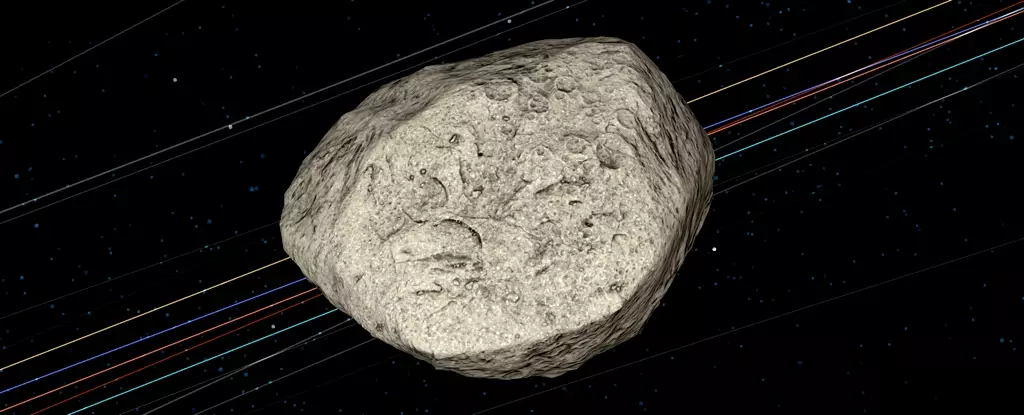The name “Apophis” evokes images of ancient Egyptian mythology, representing the god of chaos and darkness. Yet, this enigmatic asteroid, officially designated as 99942, is stirring up excitement in the scientific community as it prepares for a close encounter with Earth in April 2029. Far from presenting a danger to our planet, the real intrigue lies in how this celestial body might be altered by our planet’s gravitational influence as it glides past. This aspect is the focus of a recent study led by Ronald Ballouz and his colleagues at Johns Hopkins University Applied Physics Laboratory.
Discovered in 2004, 99942 Apophis initially sparked fears of a potential collision with Earth, with early calculations suggesting a path that could result in disaster. Thankfully, the updated trajectory adjustments and calculations have alleviated these fears, confirming that the asteroid will pass safely at a distance of less than 32,000 kilometers (approximately 20,000 miles) from Earth. This event will allow astronomers a rare opportunity to study an asteroid, providing vital data on its structure and behavior without the catastrophic consequences of an impact.
However, the question remains: as Apophis approaches Earth, how will it fare under the influence of our planet’s formidable gravitational forces?
One of the intriguing findings of Ballouz’s investigation is the peculiar characteristics of near-Earth asteroids. Many of them exhibit loose and rubble-like surfaces, and they show signs of less weathering compared to their more distant counterparts. Typically, asteroids are believed to preserve a history that stretches back 4.5 billion years, providing a snapshot of the solar system’s formative years. So why do these near-Earth rocks seemingly defy the aging process?
To explore this enigma, researchers conducted modeling studies simulating the flyby of 99942 Apophis. Their hypothesis posits that the unique dynamics of passing close to Earth could rejuvenate the surface of the asteroid, shedding light on the mystery of its youthful appearance.
One key aspect of Ballouz’s research involved creating simulations based on what is known about 99942 Apophis’s structure, although its precise shape remains uncertain. The team used the bi-lobed asteroid 25143 Itokawa as a comparative model, modifying this shape in their simulations to assess how gravity from Earth might interact with the asteroid as it approaches.
The outcome of these simulations yielded significant conclusions. As Apophis gets closer, it is projected to experience intense seismic activities resulting from NASA’s best-kept secret: the gravitational pull of Earth. This shaking could indeed lead to observable alterations on the surface, transforming Apophis in ways that could be studied using terrestrial instruments.
One of the primary effects anticipated from the 2029 flyby is an alteration in the rotation of Apophis. While the immediate impact will manifest as short-term seismic events, over time, the interactions with Earth may lead to a change in the asteroid’s rotational dynamics. Such a transformation could significantly refresh the surface of Apophis, making it look markedly different tens of thousands of years from now, as it continues its orbit around the Sun.
According to analyses conducted in previous studies, the threshold for significant alteration in an asteroid’s spin state, due to gravitational pull, falls within a distance of approximately 102,000 kilometers from Earth—substantially further than Apophis’s predicted orbit. This raises questions about the nature of the asteroid and its long-term evolution.
With its path skimming so close to Earth, the flyby of 99942 Apophis is not merely an astronomical event; it’s an opportunity for groundbreaking scientific observation. The asteroid is expected to be visible to the naked eye, providing scientists and skywatchers alike with a chance to observe a near-Earth object unlike any before.
Beyond the immediate thrill of witnessing this cosmic traveler, there is hope that this encounter could offer new insights into the nature of asteroids and the forces that shape them. As we prepare to witness this celestial phenomenon, the scientific community eagerly anticipates the effects on Apophis—ready to unravel its mysteries while keenly hoping it doesn’t return bearing a grudge.
99942 Apophis exemplifies the delicate balance in the solar system: while Earth may not be in danger from this asteroid, it may inadvertently sculpt the future of this rock from the depths of space. The implications of this encounter stretch far beyond mere observation, potentially impacting our understanding of both asteroids and the environment in which they travel.


Leave a Reply